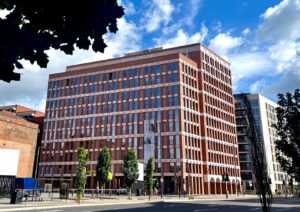
Sponsored article: Social infrastructure—the physical assets where social services as provided to communities—has a crucial role to play in society. Raymond Jacobs and John Levy share their thoughts on the topic.
Franklin Templeton Social Infrastructure strategy
Long-term, flexible and efficient investment in education, health and affordable housing is widely considered essential for economic growth and the well-being of populations.
Funding Pressure on Social Infrastructure
Across the world, there’s evidence that social infrastructure assets are severely underfunded, and some investments may not always be appropriate as needs and expectations change over the coming decades.
For example, a 2018 report compiled by the European Commission and the European Association of Long-Term Investors (ELTI) warned that investment in social infrastructure, both private and public, falls far short of the level needed to cater to the European Union’s current population.*
The report estimated the minimum infrastructure gap in social infrastructure investment to be between €100bn and €150bn a year, representing a total gap of more than €1.5trn in 2018- 2030.**
A shortage of social infrastructure assets such as schools, hospitals and affordable housing can mean not enough social services are being provided to communities.
Even among existing social infrastructure assets, the quality of the stock is often lower than one might like, and the environmental footprint considerably larger.
The aim of our social infrastructure strategy, which incorporates a strong focus on impact investing, is to tackle that problem head-on by facilitating hired, housed and healthy communities. By contributing to improvements in the quantity and quality of social infrastructure stock, we think these outcomes are obtainable.
Financial and Impact: Our Asset Management Approach
Our social infrastructure strategy has both financial and impact objectives. As we develop our asset management plan, we set short-term, medium-term and long-term objectives for both.
For example, short-term financial objectives might include leasing up vacant space, addressing short-term lease expiries, managing tenant expansion and facilitating immediate capital expenditure that might be necessary.
From an impact perspective, short-term activity might include collecting energy consumption data. Over the medium term, we’d look to use that data to make environmental improvements at the physical assets.
Longer term, our focus from a financial perspective is on lease renewals and potential redevelopment opportunities at properties. On the impact side, our longer-term attention is on possible upgrades of building equipment and systems.
14 July 2021
Room151’s LGPS Quarterly Webcast
CHINA: GROWTH & ESG
China is the growth opportunity global investors have described as being “too big to miss”. In our next LGPS webcast we ask why China is poised to retain its position as fastest growing global economy and whether investment in the super power is compatible with LGPS.
Qualifying officers from administering authorities of the scheme can register here
All enquiries to events@room151.co.uk
How Do We Make an Impact?
We view the provision of long-term capital that’s aligned with the interest of the asset as a critical element in social infrastructure investing and management.
But in order to achieve our goals, we think it’s not enough merely to align ourselves with these assets, we want to think about how we can contribute to better outcomes and better impacts.
We see it as our duty to raise the level of discussion and focus on how we achieve new and better results. We believe the focus on defining and measuring real contributions should be a primary consideration when assessing an impact strategy.
For many investors, the United Nations’ Sustainable Development Goals (SDGs) act as a common language for discussing, managing and reporting on impact investment strategies.
We feel strongly that investment products labelled as “aligned with the SDGs” should move beyond just alignment and make a real contribution to positive social and environmental outcomes.
Investing for the Long Term
Social infrastructure investing isn’t just an opportunistic move for us for the short term. We want to be involved with projects for the long term, so we can make sure that impact is long lasting.
We’re finding many opportunities to directly increase the stock of social infrastructure. For example, if we were to own property that’s primarily used as a school, but which includes some non-social infrastructure tenants, we could look at opportunities to bring in more social infrastructure tenants to that asset.
We could also look to add space to a facility for example, by adding a new floor to a building or by adding an entire new building.
The quality of services at the asset is important. When investing in infrastructure assets, we aim to partner with high-quality operators or make measurable improvements by buying an asset with a struggling operator and bring in better one.
We aim to deliver impact to our infrastructure assets in two principal ways—through functional enhancements and environmental upgrades.
Functional enhancements are essentially the physical improvement to the asset. For example, in an affordable housing project, a functional enhancement might include improving the actual apartments in the complex. In an affordable housing complex, we might work with a local telecommunications company to provide free Wi-Fi for tenants in a building; or we might try to work with a local municipality to provide better transportation options for staff to get to work at a school or hospital, for example.
Environmental upgrade examples might include installing solar panels, improving heating systems and identifying and implementing best practices associated with waste management at our assets. One practical example that’s already underway is the installation of smart meters at a number of our largest properties.
These will allow us to measure electricity, gas and water used in those buildings. We will then be able to work with tenants to improve behaviour and the efficiency of their systems.
We typically look for long leases on our assets that allow us to build relationships with both tenants and the local community to identify ways to improve the impact of that asset.
In most cases, the tenants in these structures are paying utility expenses themselves. We can get to managers and decision-makers to help them see the financial and impact benefits of the improvements we recommend.
Social infrastructure plays a critical role in the health and vibrancy of local communities. As physical assets, social infrastructure also has a large role in the health of our planet.
Without adequate resources to maintain and improve social infrastructure, we believe communities are not well served and the environment suffers. In our view, bringing impact-focused private capital to the social infrastructure space can markedly improve the performance of these assets, which in turn can help better protect the environment and those that live in the community.
To read more about the Franklin Templeton Social Infrastructure strategy, click here.
Raymond Jacobs is managing director and John Levy director of impact at Franklin Real Asset Advisors.
*European Commission: Boosting Investment in Social Infrastructure in Europe January 2018
** Ibid.
Photo by Daan Stevens on Unsplash
AWARDS INFORMATION
Read about the awards here.
Read about the seven categories here.
See the nominations here.
To read case studies of finance team impact, click here.
————————————-
FREE monthly newsletters
Subscribe to Room151 Newsletters
Room151 Linkedin Community
Join here
Monthly Online Treasury Briefing
Sign up here with a .gov.uk email address
Room151 Webinars
Visit the Room151 channel












